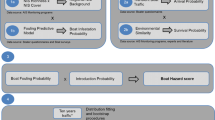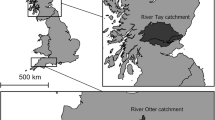Abstract
In marine systems subject to vessel traffic, the likelihood of an invasion by an exotic species typically increases with the arrival of each infested boat. In this paper, recreational boating activity patterns and boat fouling by tunicates were compared between eastern Canada and central New Zealand, and the relative importance of boat characteristics on fouling was evaluated using Boosted Regression Tree analysis. For Canada, we also determined the relative importance of boat characteristics and propagule exposure (i.e., the interaction between tunicate density in source region and time in water) on patterns of boat fouling. Approximately half of boats examined during the fall in eastern Canada and during the summer in central New Zealand were fouled by tunicates. Although there was a greater richness of tunicate species on New Zealand boats, the two countries had several species or genera in common, including Botryllus schlosseri, Ciona spp. and Botrylloides spp. The time since last boat maintenance was longer in New Zealand than in Canada. However, boat fouling and boat-mediated spread may be facilitated in Canada by boating activity patterns there, as the movement of boats among multiple marinas is considerably greater than in New Zealand. Among the boat characteristics, voyage type, the time that boats spent in water (Canada) and time since last application of antifouling paint (New Zealand) were among the best predictors of boat fouling. However, our results from Canada showed that propagule exposure was more important than boat characteristics in predicting the presence of the invasive colonial tunicate, B. schlosseri. This study shows the importance of small boats as potential vectors for tunicates and demonstrates that predictive models for the spread of biofouling species should be based on regional boating patterns, boating characteristics, and local propagule exposure.





Similar content being viewed by others
References
Acosta H, Forrest BM (2009) The spread of marine non-indigenous species via recreational boating: a conceptual model for risk assessment based on fault tree analysis. Ecol Model 220(13–14):1586–1598. doi:10.1016/J.Ecolmodel.2009.03.026
Ashton G, Boos K, Shucksmith R, Elizabeth E (2006) Risk assessment of hull fouling as a vector for marine non-natives in Scotland. Aquat Invasions 1:214–218. doi:10.3391/ai.2006.1.4.4
Ayre DJ, Davis AR, Billingham M, Llorens T, Styan C (1997) Genetic evidence for contrasting patterns of dispersal in solitary and colonial ascidians. Mar Biol 130:51–61. doi:10.1007/s002270050224
Brewin BI (1946) Ascidians in the vicinity of the Portobello Marine Biological Station, Otago Harbour. Trans R Soc N Z 76:87–131
Carlton JT (1989) Man’s role in changing the face of the ocean: biological invasions and implications for conservation of near-shore environments. Conserv Biol 3:265–273. doi:10.1111/j.1523-1739.1989.tb00086.x
Carlton JT (1996) Pattern, process, and prediction in marine invasion ecology. Biol Conserv 78:97–106. doi:10.1016/0006-3207(96)00020-1
Carlton JT, Geller JB (1993) Ecological roulette: the global transport of nonindigenous marine organisms. Science 261:78–82. doi:10.1126/science.261.5117.78
Carver CE, Mallet AL, Vercaemer B (2006) Biological synopsis of the colonial tunicates, Botryllus schlosseri and Botrylloides violaceus. Can Man Rep Fish Aquat Sci 2747:v + 42
Clarke Murray C, Pakhomov EA, Therriault TW (2011) Recreational boating: a large unregulated vector transporting marine invasive species. Biodivers Res 17:1161–1172
Clarke Murray C, Therriault TW, Mortone PT (2012) Adapted for invasion? Comparing attachment, drag and dislodgement of native and nonindigenous hull fouling species. Biol Invasions. doi:10.1007/s10530-012-0178-0
Coutts ADM, Forrest BM (2007) Development and application of tools for incursion response: lessons learned from the management of the fouling pest Didemnum vexillum. J Exp Mar Biol Ecol 342:154–162. doi:10.1016/j.jembe.2006.10.042
Coutts ADM, Taylor MD (2004) A preliminary investigation of biosecurity risks associated with biofouling on merchant vessels in New Zealand. N Z J Mar Fresh Res 38:215–229. doi:10.1080/00288330.2004.9517232
Coutts ADM, Piola RF, Taylor MD, Hewitt CL, Gardner JP (2010a) The effect of vessel speed on the survivorship of biofouling organisms at different hull locations. Biofouling 26:539–553. doi:10.1080/08927014.2010.492469
Coutts ADM, Piola RF, Hewitt CL, Connell SD, Gardner JPA (2010b) Effect of vessel voyage speed on survival of biofouling organisms: implications for translocation of non-indigenous marine species. Biofouling 26:1–13. doi:10.1080/08927010903174599
Davidson IC, Zabin CJ, Chang AL, Brown CW, Sytsma MD, Ruiz GM (2010) Recreational boats as potential vectors of marine organisms at an invasion hotspot. Aquat Biol 11:179–191. doi:10.3354/ab00302
Davis M, Davis M (2006) Styela clava (Tunicata: Ascidiacea) a new edition to the fauna of New Zealand. Porcup Mar Nat Hist Soc Newsl 20:19–22
Elith J, Leathwick JR, Hastie T (2008) A working guide to boosted regression trees. J Anim Ecol 77:802–813. doi:10.1111/j.1365-2656.2008.01390.x
Floerl O, Inglis GJ (2003) Boat harbour design can exacerbate hull fouling. Aust Ecol 28:116–127. doi:10.1111/j.1442-9993.2003.tb00235.x
Floerl O, Inglis GJ (2005) Starting the invasion pathway: the interaction between source populations and human transport vectors. Biol Invasions 7:589–606. doi:10.1007/s10530-004-0952-8
Floerl O, Inglis GJ, Hayden BJ (2005) A risk-based predictive tool to prevent accidental introductions of nonindigenous marine species. Environ Manage 35:765–778. doi:10.1007/s00267-004-0193-8
Glasby TM, Connell SD, Holloway MG, Hewitt CL (2007) Nonindigenous biota on artificial structures: could habitat creation facilitate biological invasions? Mar Biol 151:887–895. doi:10.1007/s00227-006-0552-5
Godwin LS (2005) Maritime activities as a mechanism for introducing marine alien species: Issues and management. In: Godwin LS (ed) Hull fouling as a mechanism for marine invasive species introductions. Proceedings of a workshop on current issues and potential management strategies, Honolulu, Hawaii, pp 1–5
Greene CH, Schoener A, Corets E (1983) Succession on marine hard substrata—the adaptive significance of solitary and colonial strategies in temperate fouling communities. Mar Ecol Prog Ser 13:121–129
Grosberg RK, Quinn JF (1986) The genetic-control and consequences of kin recognition by the larvae of a colonial marine invertebrate. Nature 322:456–459. doi:10.1038/322456a0
Hanley JA, Mcneil BJ (1982) The meaning and use of the area under a receiver operating characteristic (roc) curve. Radiology 143:29–36
Howes S, Herbinger CM, Darnell P, Vercaemer B (2007) Spatial and temporal patterns of recruitment of the tunicate Ciona intestinalis on a mussel farm in Nova Scotia, Canada. J Exp Mar Biol Ecol 342:85–92. doi:10.1016/j.jembe.2006.10.018
Humphrey DB (2008) Characterizing ballast water as a vector for nonindigenous zooplancton transport. MSc Dissertation, University of British Columbia
Inglis G, Gust N, Fitridge I, Floerl O, Woods C, Hayden B, Fenwick G (2006) Baseline survey for non-indigenous marine species. National Institute of Water & Atmospheric Research Ltd. http://www.maf.govt.nz/mafnet/publications/biosecurity-technical-papers/. Accessed 20 Aug 2010
Jackson JBC (1977) Competition on marine hard substrata—adaptive significance of solitary and colonial strategies. Am Nat 111:743–767
Kolar CS, Lodge DM (2001) Progress in invasion biology: predicting invaders. Trends Ecol Evol 16:199–204. doi:10.1016/S0169-5347(01)02101-2
Lambert CC, Lambert G (1998) Non-indigenous ascidians in southern California harbors and marinas. Mar Biol 130:675–688. doi:10.1007/s002270050289
Lambert CC, Lambert G (2003) Persistence and differential distribution of nonindigenous ascidians in harbors of the Southern California Bight. Mar Ecol Prog Ser 259:145–161. doi:10.3354/meps259145
Leathwick JR, Elith J, Chadderton WL, Rowe D, Hastie T (2008) Dispersal, disturbance and the contrasting biogeographies of New Zealand’s diadromous and non-diadromous fish species. J Biogeogr 35:1481–1497. doi:10.1111/j.1365-2699.2008.01887.x
Lockwood JL, Cassey P, Blackburn T (2005) The role of propagule pressure in explaining species invasions. Trends Ecol Evol 20:223–228. doi:10.1016/j.tree.2005.02.004
Lockwood JL, Cassey P, Blackburn TM (2009) The more you introduce the more you get: the role of colonization pressure and propagule pressure in invasion ecology. Divers Distrib 15:904–910. doi:10.1111/j.1472-4642.2009.00594.x
MacDougall AS, Turkington R (2005) Are invasive species the drivers or passengers of change in degraded ecosystems? Ecology 86:42–55. doi:10.1890/04-0669
Mckindsey CW, Landry T, O’Beirn FX, Davies IN (2007) Bivalve aquaculture and exotic species: a review of ecological considerations and management issues. J Shellfish Res 26:281–294. doi:10.2983/0730-8000(2007)26[281:BAAESA]2.0.CO;2
Mikheyev AS, Tchingnoumba L, Henderson A, Alonso A (2008) Effect of propagule pressure on the establishment and spread of the little fire ant Wasmannia auropunctata in a Gabonese oilfield. Divers Distrib 14:301–306. doi:10.1111/j.1472-4642.2007.00463.x
Minchin D, Floerl O, Savini D, Occhipinti-Ambrogi A (2006) Small craft and the spread of exotic species. In: Davenport J, Davenport JL (eds) The ecology of transportation: managing mobility for the environment, vol 10. Springer, Dordrecht, pp 99–118
NIWA (2003) Aquatic biodiversity and biosecurity. A quarterly newsletter from the National Center for Aquatic Biodiversity and Biosecurity, Issue 5
Pimm SL (1991) The balance of nature? Ecological issues in the conservation of species and communities. The University of Chicago Press, Chicago
Piola RF, Forrest B (2009) Options for managing biosecurity risks from recreational vessel hubs. Cawthron Report No. 1591. p 51
Piola RF, Dafforn KA, Johnston EL (2009) The influence of antifouling practices on marine invasions. Biofouling 25:633–644. doi:10.1080/08927010903063065
Ramsay A, Davidson J, Bourque D, Stryhn H (2009) Recruitment patterns and population development of the invasive ascidian Ciona intestinalis in Prince Edward Island, Canada. Aquat Invasions 4:169–176. doi:10.3391/ai.2009.4.1.17
Ruiz G, Carlton J, Grosholz E, Hines A (1997) Global invasions of marine and estuarine habitats by non-indigenous species: mechanisms, extent, and consequences. Am Zool 37:621–632. doi:10.1093/icb/37.6.621
Smith KF, Cahill PL, Fidler AE (2010) First record of the solitary ascidian Ciona savignyi Herdman, 1882 in the Southern Hemisphere. Aquat Invasions 5:363–368. doi:10.3391/ai.2010.5.4.05
Sylvester F, MacIsaac HJ (2010) Is vessel hull fouling an invasion threat to the great lakes? Divers Distrib 16:132–143. doi:10.1111/j.1472-4642.2009.00622.x
Sylvester F, Kalaci O, Leung B, Lacoursière-Roussel A, Clarke Murray C, Choi FM, Bravo MA, Therriault TW, MacIsaac HJ (2011) Hull fouling as an invasion vector: can simple models explain a complex problem? J Appl Ecol 48:415–423. doi:10.1111/j.1365-2664.2011.01957.x
Tyrrell MC, Byers JE (2007) Do artificial substrates favor nonindigenous fouling species over native species? J Exp Mar Biol Ecol 342:54–60. doi:10.1016/j.jembe.2006.10.014
Veltman CJ, Nee S, Crawley MJ (1996) Correlates of introduction success in exotic New Zealand birds. Am Nat 147:542–557
Williamson M (1996) Biological invasions. Chapman & Hall, London
Wonham MJ, Walton WC, Ruiz GM, Frese AM, Galil BS (2001) Going to the source: role of the invasion pathway in determining potential invaders. Mar Ecol Prog Ser 215:1–12. doi:10.3354/meps215001
Woods Hole (1952) Marine fouling and its prevention; prepared for Bureau of Ships, Navy Dept. Woods Hole Open Access Server. URL: http://hdl.handle.net/1912/191. Accessed 4 Mar 2012
Acknowledgments
We thank managers and boat owners in Canada and New Zealand for their help and permission to let us distribute questionnaires and to survey boats. Sophie Comtois, Jean-Charles Fleurent, Tanya Hansen, Maryse Plante-Couture, Rafael Estrada Anaya and Katie Kenny-Foeldessy for their essential help in distributing questionnaires and video surveying. Benedikte Vercaemer and Joanne Keays helped with field set-up. Rod Asher analyzed and identified specimens on video footages from New Zealand. Grant Hopkins, Lauren Fletcher, Eric Goodwin, Tanya Compton and Annick Drouin helped analyze and interpret results and gave insightful comments and ideas and Andréa Weise helped with the figures. We thank Nathalie Simard, Carla Barkhouse, Andrea Locke, Dawn Sephton, and Jennifer L. Martin for sharing tunicate abundance data obtained within marina surveys done by Fisheries and Ocean Canada (DFO). We also thank James Carleton and an anonymous reviewer for detailed comments on an earlier draft of the manuscript. Funding for this study was mainly provided by the Canadian Invasive Species Network (CAISN) and fieldwork was also funded by DFO and the Cawthron Institute (OBI contract C01X0502: Effective Management of Marine Biodiversity and Biosecurity). A. Lacoursière-Roussel was further supported by scholarships from McGill University and the Fonds de recherche sur la nature et les technologies (FQRNT) and F. Guichard was supported by Québec-Océan and a Discovery grant from the Natural Sciences and Engineering Research Council (NSERC).
Author information
Authors and Affiliations
Corresponding author
Electronic supplementary material
Below is the link to the electronic supplementary material.
Rights and permissions
About this article
Cite this article
Lacoursière-Roussel, A., Forrest, B.M., Guichard, F. et al. Modeling biofouling from boat and source characteristics: a comparative study between Canada and New Zealand. Biol Invasions 14, 2301–2314 (2012). https://doi.org/10.1007/s10530-012-0230-0
Received:
Accepted:
Published:
Issue Date:
DOI: https://doi.org/10.1007/s10530-012-0230-0




